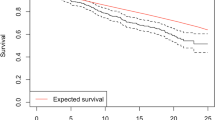Abstract
Neurological symptoms present in neonates with spinal dysraphism often progress with growth. A simple, objective scoring system for quantitative analysis of spinal neurological deficits, called the Spina Bifida Neurological Scale (SBNS), is proposed. Scoring is based on (1) motor function, (2) reflexes, and (3) bladder and bowel function. These are each divided into six, four, and five points respectively with respect to the level of spinal funcion. Motor function and reflexes are bilaterally analyzed, and the maximum SBNS score of 15 points reflects a normal spinal neurological state (grade I). This scoring system was correlated with the clinical condition of 89 patients with spinal bifida who were graded from I to V. A total score of less than 5 was associated with a nonambulatory state (grade IV or V) in 84.0% of patients, and a score of 5–9 was associated with an ambulatory state (grade III) in 93.8% of patients. Scores of 10–14 reflected control of bladder and bowel function (grade II) in all patients. The application of a standardized scoring scheme will assist in the evaluation of patients' clinical status and will enable analysis of chronological changes in neurological function.
Similar content being viewed by others
References
Chusid JG (1976) Correlative neuroanatomy and functional neurology, 16th edn. Lange, Los Altos, Calif
Drake CG (1988) Report of World Federation of Neurological Surgeons Committee on a universal subarachnoid hermorrhage grading scale. J Neurosurg 68:985–986
Hoffman HJ, Hendrick EB, Humphreys RP (1976) The tethered spinal cord: its protean manifestations, diagnosis and surgical correction. Child's Brain 2:145–155
Hoppenfeld S (1977) Orthopaedic neurology — a diagnostic guide to neurologic levels. Lippincott, Philadelphia
Hunt WE, Hess RM (1968) Surgical risk as related to time of intervention in the repair of intracranial aneurysms. J Neurosurg 28:14–20
Jennett B, Teasdale G (1977) Aspects of coma after severe head injury. Lancet 1:878–881
Ohta T, Waga S, Handa H, et al (1974) New grading of level of disordered consciousness (in Japanese). No shinkei Geka 2:623–627
Oi S, Matsumoto S (1988) Tethered cord syndrome. Neurosurgeons 7:117–132
Oi S, Yamada H, Matsumoto S (1990) Tethered cord syndrome versus low-placed conus medullaris in an over-distended spinal cord following initial repair for myelodysplasia. Child's Nerv Syst 6:264–269
Pang D, Wilberger JE (1982) Tethered cord syndrome in adults. J Neurosurg 57:32–47
Raimondi AJ, Hirschauer J (1984) Head injury in the infants and toddler. Coma scoring and outcoma scale. Child's Brain 11:12–35
Sano K, Manaka S, Kitamura K, et al (1983) Statistical studies on evaluation of mild disturbance of consciousness. J Neurosurg 58:223–230
Shi YO, Chen XC (1986) A proposed scheme for grading intracranial arteriovenous malformations. J Neurosurg 65:484–489
Smith ED (1965) Spinal bifida and the total care of spinal myelomenigocele. Thomas, Springfield, Ill
Spetzler RF, Martin NA (1986) A proposed grading system for arteriovenous malformations. J Neurosurg 65:476–483
Starmark JE, Stalhammer D, Hilmaren E, Bosander B (1988) A comparison of the Glasgow Coma Scale and the reaction level scale (RLS85). J Neurosurg 69:699–706
Author information
Authors and Affiliations
Rights and permissions
About this article
Cite this article
Oi, S., Matsumoto, S. A proposed grading and scoring system for spina bifida: Spina Bifida Neurological Scale (SBNS). Child's Nerv Syst 8, 337–342 (1992). https://doi.org/10.1007/BF00296565
Received:
Issue Date:
DOI: https://doi.org/10.1007/BF00296565




